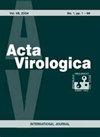Detection of SARS-CoV-2 using a laboratory-developed ultra-fast NextGenPCR test versus a conventional RT-PCR test
IF 0.8
4区 医学
Q4 VIROLOGY
引用次数: 0
Abstract
The reverse transcription polymerase chain reaction (RT-PCR) is considered the gold standard method for the detection of viruses in a clinic. The aim of this study was to compare the ability of conventional RT-PCR test (FTD TM SARS-CoV-2 Test) and laboratory-developed ultra-fast PCR test (NextGenPCR TM SARS-CoV-2 RT-PCR Reagent Kit) to detect the coronavirus SARS-CoV-2 causing COVID-19. A total of 318 nasopharyngeal swab specimens were collected from people under investigation for COVID-19. Despite the collection of two swab specimens from each patient and their different processing, the analysis showed an overall agreement of 95.9% between the conventional and laboratory-developed tests. The positive percentage agreement was 90.5% (114/126) and the negative percentage agreement was 99.5% (191/192). The ultra-fast NextGenPCR method does not require the isolation of RNA, provides a result of 20–96 specimens within 57–82 min after sampling, and offers a simple procedure of sample processing, analysis, and evaluation. Our results indicate that this method can be considered a potential diagnostic method for the detection of SARS-CoV-2 virus in hospitals, healthcare facilities, and research laboratories.使用实验室开发的超快速NextGenPCR检测与传统RT-PCR检测SARS-CoV-2的比较
逆转录聚合酶链反应(RT-PCR)被认为是临床检测病毒的金标准方法。本研究的目的是比较传统RT-PCR检测(FTD TM SARS-CoV-2 test)和实验室开发的超快速PCR检测(NextGenPCR TM SARS-CoV-2 RT-PCR试剂盒)检测引起COVID-19的冠状病毒SARS-CoV-2的能力。从接受COVID-19调查的人员中共收集了318份鼻咽拭子标本。尽管从每位患者身上采集了两个拭子标本,处理方法也不同,但分析显示,常规检测与实验室开发的检测之间的总体一致性为95.9%。阳性比例为90.5%(114/126),阴性比例为99.5%(191/192)。超快速NextGenPCR方法不需要分离RNA,在取样后57-82分钟内提供20-96个标本的结果,并提供简单的样品处理、分析和评估程序。我们的结果表明,该方法可以被认为是在医院、医疗机构和研究实验室检测SARS-CoV-2病毒的潜在诊断方法。
本文章由计算机程序翻译,如有差异,请以英文原文为准。
求助全文
约1分钟内获得全文
求助全文
来源期刊

Acta virologica
医学-病毒学
CiteScore
3.10
自引率
11.80%
发文量
43
审稿时长
>12 weeks
期刊介绍:
Acta virologica is an international journal of predominantly molecular and cellular virology. Acta virologica aims to publish papers reporting original results of fundamental and applied research mainly on human, animal and plant viruses at cellular and molecular level. As a matter of tradition, also rickettsiae are included. Areas of interest are virus structure and morphology, molecular biology of virus-cell interactions, molecular genetics of viruses, pathogenesis of viral diseases, viral immunology, vaccines, antiviral drugs and viral diagnostics.
 求助内容:
求助内容: 应助结果提醒方式:
应助结果提醒方式:


